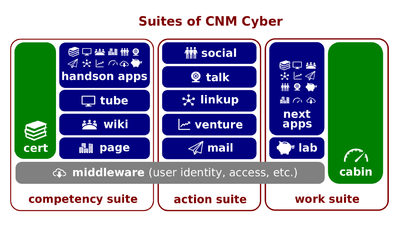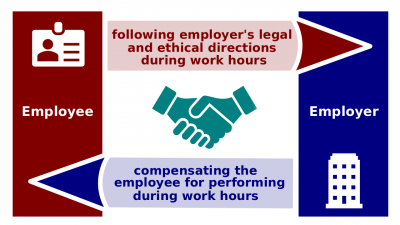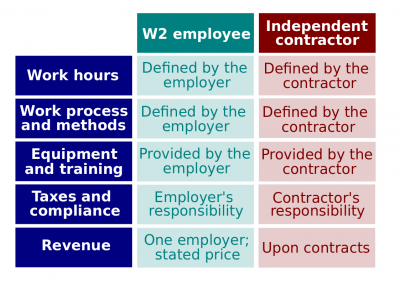Difference between revisions of "Employment Essentials"
(→Outline) |
|||
| (29 intermediate revisions by 2 users not shown) | |||
| Line 1: | Line 1: | ||
| − | [[File:Cnm-digital.png|400px|thumb|right|[[ | + | [[File:Cnm-digital.png|400px|thumb|right|[[CNMCyber suite]]s]]The [[Employment Essentials]] (hereinafter, the ''Lesson'') is the [[lesson]] of [[CNMCyber]] that introduces its participants to Employment and job market. The ''Lesson'' belongs to the '''[[Introduction to Employment]]''' session of [[EmployableU Concepts]]. |
| − | The ''Lesson'' is made up of | + | The ''Lesson'' is made up of six [[lectio]]s. At [[CNMCyber]], the word, [[lectio]], is used for a lesson part. |
==Summaries== | ==Summaries== | ||
===Predecessor=== | ===Predecessor=== | ||
| − | :The | + | :No [[learning activity]] precedes the ''Lesson'' in [[EmployableU Concepts]]; this ''Lesson'' is the first one. [[WorldOpp Orientation]] is the pre-requisite to [[EmployableU Concepts]]. The last [[lesson activity|lesson]] of [[WorldOpp Orientation]] is [[Beyond the Session]]. |
===Outline=== | ===Outline=== | ||
| Line 15: | Line 15: | ||
|- | |- | ||
![[What Employment Is]] | ![[What Employment Is]] | ||
| − | |1|| | + | |1||[[Employment]], [[Work Motivation Model]], [[work-life fit]], [[employment agreement]], [[agreement]] |
|- | |- | ||
| − | ![[ | + | ![[Work Sellers]] |
| − | |2|| | + | |2||[[Worker]], [[employee]], [[independent contractor]], [[self-employed]], [[self-employment]], [[gig economy]], [[freelancer]], [[workforce]] |
|- | |- | ||
| − | ![[Employee | + | ![[Volunteer Workers]] |
| − | | | + | |3||[[Volunteer]], [[employment candidate]], [[entrepreneur]], [[volunteering]] |
| + | |- | ||
| + | ![[Student Workers]] | ||
| + | |4||[[Student worker]], [[apprentice]], [[intern]], [[paid intern]], [[unpaid intern]] | ||
| + | |- | ||
| + | ![[Employee Remunerations]] | ||
| + | |5||[[Employee compensation]], [[cash remuneration]], [[employee benefit]], [[payroll service provider]], [[payroll]], [[wages]], [[salary]] | ||
|- | |- | ||
![[Labor Relations]] | ![[Labor Relations]] | ||
| − | | | + | |6||[[Labor relations]], [[labor organization]], [[labor union]], [[collective bargaining agreement]] ([[Collective bargaining agreement|CBA]]) |
|} | |} | ||
===Successor=== | ===Successor=== | ||
| − | :The successor lesson is [[ | + | :The successor lesson is [[Industries and Specialties]]. |
| − | |||
| − | |||
| − | |||
| − | |||
| − | |||
| − | |||
| − | |||
| − | |||
| − | |||
| − | |||
| − | |||
| − | |||
| − | |||
| − | |||
| − | |||
| − | |||
| − | |||
| − | |||
| − | |||
| − | |||
| − | |||
| − | |||
| − | |||
| − | + | ==2019 Employment presentation== | |
| − | + | The video of the presentation is published on https://youtu.be/VncYRPGLyvQ (9:35). Here is its full text. | |
| − | |||
| − | |||
| − | |||
| − | |||
| − | |||
| − | |||
| − | |||
| − | |||
| − | |||
| − | |||
| − | |||
| − | |||
| − | The video of the presentation is published | ||
===Overview=== | ===Overview=== | ||
| Line 77: | Line 47: | ||
:When you take a look at the picture under employment overview, on the left it`s simply an employee giving an employer their performance. They follow directions during work hours. Directions should be legal and ethical. Because when a direction is not legal an employee can decline the directions given. An employer is compensating an employee for performance and this is a willful agreement. This means that both employee and employer agree on the same cause. If either the employee or employer is not happy with the other and want to cancel the contract, there should be following of a procedure on how to terminate the contract. | :When you take a look at the picture under employment overview, on the left it`s simply an employee giving an employer their performance. They follow directions during work hours. Directions should be legal and ethical. Because when a direction is not legal an employee can decline the directions given. An employer is compensating an employee for performance and this is a willful agreement. This means that both employee and employer agree on the same cause. If either the employee or employer is not happy with the other and want to cancel the contract, there should be following of a procedure on how to terminate the contract. | ||
| + | ====What Occupation Is==== | ||
:Employers are hiring for certain occupations and certain industries. Occupation is the regular activity that the person undertakes in order to earn his/her livelihood. For instance, a teacher or a driver or a construction worker or a manager is an occupation. An industry is any part of economy, a group of enterprises that create a particular type of products, for example car industries produces cars, computer I.T industry produces software, computer industries produces computers. | :Employers are hiring for certain occupations and certain industries. Occupation is the regular activity that the person undertakes in order to earn his/her livelihood. For instance, a teacher or a driver or a construction worker or a manager is an occupation. An industry is any part of economy, a group of enterprises that create a particular type of products, for example car industries produces cars, computer I.T industry produces software, computer industries produces computers. | ||
| Line 96: | Line 67: | ||
===Summary=== | ===Summary=== | ||
:This concludes the ''Employment Essentials'' presentation. We have defined [[employment]] and an [[industry]], mentioned [[labor law]]s, and taken a closer look at most common [[job-market actor|actor]]s on the [[job market]]. Specifically, we have made stops by [[employee]]s, [[independent contractor|contractor]]s, the [[self-employed]], [[apprentice]]s, [[volunteer]]s, and [[employment candidate]]s. Differences between [[employment]] and contracting were considered in greater details. If you haven't done yet so, you are now welcome to move to [[Nature of Occupations]]. | :This concludes the ''Employment Essentials'' presentation. We have defined [[employment]] and an [[industry]], mentioned [[labor law]]s, and taken a closer look at most common [[job-market actor|actor]]s on the [[job market]]. Specifically, we have made stops by [[employee]]s, [[independent contractor|contractor]]s, the [[self-employed]], [[apprentice]]s, [[volunteer]]s, and [[employment candidate]]s. Differences between [[employment]] and contracting were considered in greater details. If you haven't done yet so, you are now welcome to move to [[Nature of Occupations]]. | ||
| − | |||
| − | |||
| − | |||
| − | |||
| − | |||
| − | |||
| − | |||
| − | |||
| − | |||
| − | |||
| − | |||
| − | |||
| − | |||
| − | |||
| − | |||
| − | |||
| − | |||
| − | |||
| − | |||
| − | |||
| − | |||
| − | |||
| − | |||
| − | |||
| − | |||
[[Category: Orientation Curriculum]][[Category:Presentations]] | [[Category: Orientation Curriculum]][[Category:Presentations]] | ||
Latest revision as of 22:30, 29 October 2023
The Employment Essentials (hereinafter, the Lesson) is the lesson of CNMCyber that introduces its participants to Employment and job market. The Lesson belongs to the Introduction to Employment session of EmployableU Concepts.
The Lesson is made up of six lectios. At CNMCyber, the word, lectio, is used for a lesson part.
Contents
Summaries
Predecessor
- No learning activity precedes the Lesson in EmployableU Concepts; this Lesson is the first one. WorldOpp Orientation is the pre-requisite to EmployableU Concepts. The last lesson of WorldOpp Orientation is Beyond the Session.
Outline
Successor
- The successor lesson is Industries and Specialties.
2019 Employment presentation
The video of the presentation is published on https://youtu.be/VncYRPGLyvQ (9:35). Here is its full text.
Overview
- Welcome to Employment Essentials. In this brief presentation, we are going to take a look at employment and the job market in general. We will also make a short stop at labor law, which surely deserves the whole course, but we will have to squeeze it to the minimum for now. Let's go.
What Employment Is
- Employment is basically an agreement between employer and employee. Employers agree to compensate employees for their work done and employees agree to follow employer’s directions during work hours in exchange for employer`s compensation. Employment can refer to process or result of that exchange.
- When you take a look at the picture under employment overview, on the left it`s simply an employee giving an employer their performance. They follow directions during work hours. Directions should be legal and ethical. Because when a direction is not legal an employee can decline the directions given. An employer is compensating an employee for performance and this is a willful agreement. This means that both employee and employer agree on the same cause. If either the employee or employer is not happy with the other and want to cancel the contract, there should be following of a procedure on how to terminate the contract.
What Occupation Is
- Employers are hiring for certain occupations and certain industries. Occupation is the regular activity that the person undertakes in order to earn his/her livelihood. For instance, a teacher or a driver or a construction worker or a manager is an occupation. An industry is any part of economy, a group of enterprises that create a particular type of products, for example car industries produces cars, computer I.T industry produces software, computer industries produces computers.
Employees
- Looking at employment roles, the first employment role is an employee who is any individual employed by the employer for some compensation. Most likely this includes wages or a salary though neither wages nor salary is the only compensation. Employers often offer different benefits, incentives etc.
Contractors
- Moving on to independent contractor. This is an individual or another legal entity that provides goods and services to their client under terms specified within a contract or within a verbal agreement. On the lower picture under employment, on the left there is a contractor and contractor provides the contract client with their requested products and on the right is contract client who has compensated the contractor for the requested products. The difference between these two pictures, employee is working. An employer employs an employee as a manager through some representatives says what they expect employees to do. In contracting, a contract client says contracts are what he or she wants to get out of the process.
Employee vs contractor
- Another comparison is on the table displayed, with regard to work hours, employers set work hours for employees and independent contractors define their work hours on themselves. Employer defines work processing methods for employees and contractors are responsible for that when he/she in an independent contractor. In equipment, in the employment it`s usually provided by the employer and in contracting the contractor is always responsible for their equipment and training. Taxes and compliance, employers take care of those in employment. In contracting, independent contractors basically they are self-employed, they work for themselves that is why they are responsible for this. In revenue, employee has one employer and the price is stated when the contract was made. Independent contractors can work for several clients and the price can be negotiated. It can be higher or lower.
Self-employed
- So who is self-employed? Independent contractors are basically self-employed but self-employed could also be owners of a company. In the case where someone cannot work as an employee yet but employer needs them to work, in this case the concept of apprentice is coming in. So apprentice basically is an employee but this employee is not paid the full amount or compensation which a fully skilled worker would expect to get. Apprentice pay increases as his/her skills and abilities increase. When an apprentice can work as a full employee, he/she gets the full compensation.
Volunteer
- The last role is volunteer, a volunteer is a person who does something especially help other people willfully and without being forced but the same time he/she is not paid to do that. In America it`s illegal for a profit company hire someone and not pay so volunteering in the United States exists only not for profit companies. We have looked at employment and employment roles and we are ready to go to occupations.
Summary
- This concludes the Employment Essentials presentation. We have defined employment and an industry, mentioned labor laws, and taken a closer look at most common actors on the job market. Specifically, we have made stops by employees, contractors, the self-employed, apprentices, volunteers, and employment candidates. Differences between employment and contracting were considered in greater details. If you haven't done yet so, you are now welcome to move to Nature of Occupations.



